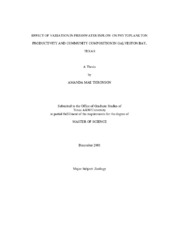| dc.description.abstract | Freshwater inflows are essential to the health of estuaries and minimum discharge levels must be maintained in order to sustain a healthy ecosystem. Due to the predicted 50% increase in urban population growth along the Texas coastline by the year 2050, water regulators and managers are faced with the challenge of meeting human needs, while maintaining essential freshwater inflows into estuarine ecosystems. Galveston Bay is of particular concern because 10 million people currently living within its watershed.
Freshwater inflows into Galveston Bay during 2006 were determined by using daily discharge data from a United States Geological Survey (USGS) sampling gauge in the Trinity River. Changes in water quality parameters, primary productivity, and phytoplankton community structure in response to freshwater inflows, were monitored monthly to determine how the phytoplankton community responded to inflow events.
Freshwater inflow into Galveston Bay during 2006 was indicative of a low-inflow year, with seven large (>7,000 ft.3 sec-1) inflow events occurring throughout the year. There were significant differences in phytoplankton biomass (Fm), photosynthetic efficiency (alpha), and photosynthetic potential (yield) of the phytoplankton community, between wet (January-April and October-December) and dry (May-September) months. Significant differences in the biomass of phytoplankton groups also occurred with cyanobacteria being present in higher concentrations during the dry months and diatoms & dinoflagellates during the wet months. Low flow periods favored cyanobacteria, which lead to decreased secondary productivity, while pulsed inflow events resulted in enhanced secondary productivity by favoring diatoms and dinoflagellates. Resource Limitation Assays (RLAs) indicated that nitrogen was a potential limiting nutrient in Galveston Bay during spring/summer, with light limitation of phytoplankton communities possibly occurring near the mouth of the Trinity River.
This study demonstrates the role of freshwater inflows in determining the primary productivity and community composition of the phytoplankton in Galveston Bay over an annual cycle. Inter-annual studies are needed to elucidate the impact of freshwater inflows in years with higher inflows to Galveston Bay and determine which of these impacts need to be incorporated into water management decisions to maintain a healthy ecosystem. | en |


